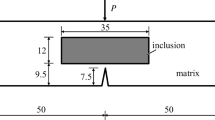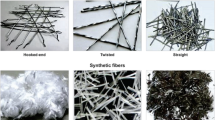Abstract
The present study has shown the experimental results for characterization of the mode I delamination fracture of continuous carbon fiber/epoxy multidirectional composites under a wide range of test rates, up to high rates of 11.4 m/s. At the slow rates of test ≤1.0 × 10−1 m/s the delamination fracture energy showed a rising “R-curve”, a strong function of the length of propagating crack due to the large extent of crack jumping and following fiber bridging. At the high rates of test ≥1.0 m/s any loads recorded by the load cell were largely obscured by such dynamic effects as “spring-mass” oscillations and flexural wave reflections. In this respect, Equation 11, requiring the values of the actual arm displacement and flexural (axial) modulus, was better for the deduction of G IC. However the maximum value of G IC so obtained was considerably underestimated. By increasing the rate up to 1.0 × 10−1 m/s, there were little differences in the delamination fracture behaviors, whereas at high rates >1.0 m/s the maximum values of G IC decreased considerably. In the case of a short initial crack length, however, the maximum values largely increased at a rate of 11.4 m/s.
Similar content being viewed by others
References
D. L. Hunston, R. J. Moulton, N. J. Johnston and W. D. Bascom, in “Matrix effects in Composite Delamination: Mode I Fracture Aspects,” Toughened Composites, edited by N. L. Johnston, ASTM STP 937 (1987) p. 74.
W. L. Bradley, “Relationship of Matrix Toughness to Interlaminar Fracture Toughness,” Application of Fracture Mechanics to Composite Materials, edited by K. Friedrich, Composite Materials Series Vol. 6 (Elsevier Science Publishers, 1989) p. 159.
X. N. Huang and D. Hull, Comp. Sci. Tech. 35 (1989) 283.
P. Davies, C. Moulin, H. H. Kausch and M. Fischer, ibid. 39 (1990) 193.
S. Hashemi, A. J. Kinloch and J.G. Williams, Proc Royal Soc. London A427 (1990) 173.
Idem., J. Comp. Mater. 24 (1990) 918.
J.G. Williams, ibid. 21 (1987) 330.
L. A. Carlsson and J.W. Gillespie, Jr., “Mode II Interlaminar Fracture of Composites,” Application of Fracture Mechanics to Composite Materials, edited by K. Friedrich, Composite Materials Series Vol. 6 (Elsevier Science Publishers, 1989) p. 113.
Y. Wang and J.G. Williams, Comp. Sci. Tech. 43 (1992) 251.
C. Corleto and W. L. Bradley, “Mixed Mode Fracture in Fibre-Polymer Composite Laminates,” Composite Materials: Fatigue and Fracture, edited by T. K. O'Brien, ASTM STP1110 (1991) p. 143.
J.J. Ploaha, B. D. Davidson, R. C. Hudson and A. Pieracci, J. Reinf. Plastics Comp. 15 (1996) 141.
D. J. Nicholls and J.P. Gallagher, ibid. 2 (1983) 2.
H. Chai, Composites 15 (1984) 277.
P. Robinson and D. Q. Song, J. Comp. Mater. 26 (1992) 1554.
N. S. Choi, A. J. Kinloch and J.G. Williams, ibid. 33 (1999) 73.
A. J. Smiley and R. B. Pipes, ibid. 21 (1987) 670.
PH. Beguelin, M. Barbezat and H. H. Kausch, Journal de Physique III France 1 (1991) 1867.
G. Yaniv and I.M. Daniel, “Hight-Tapered Double Cantelever Beam Specimen for Study of Rate Effects on Fracture Toughness of Composites,” Composite Materials: Testing and Design ASTM STP 972, edited by J. D. Whitcomb, Philadelphia (1988) p. 241.
A. A. Aliyu and I.M. Daniel, “Effects of Strain Rate on Delamination Fracture Toughness of Graphite/Epoxy,” Delamination and Bonding of Materials, ASTM STP 876, edited by W. S. Johnson, Philadelphia (1985) p. 336.
B. R. K. Blackman, J.P. Dear, A. J. Kinloch, H. Macgillivray, Y. Wang, J.G. Williams and P. Yayla, J. Mater. Sci. 30 (1995) 5885.
B. R. K. Blackman, A. J. Kinloch, Y. Wang and J.G. Williams, ibid. 30 (1996) 4451.
L. Yongning, Z. Jinghau and Z. Huijui, Eng. Frac. Mech. 39 (1991) 955.
J. Harding, “The Effect of High Strain Rate on Material Properties,” in Materials at High Strain Rates, edited by T. Z. Blazynski (Elsevier Applied Science, London, 1987) p. 133.
H. Kolsky, “Stress Waves in Solids” (Constable Dover Publications, New York, USA, 1963).
J.G. Williams, “Fracture Mechanics of Polymers” (Ellis Horwood Ltd, Chichester, UK, 1987) p. 237.
Y. Wang and J.G. Williams, Composites 25 (1994) 323.
ASTM, “Standard Test Method for Mode I Interlaminar Fracture Toughness of Unidirectional Fiber-Reinforced Polymer Matrix Composites,” D5528-94a (1994).
Author information
Authors and Affiliations
Rights and permissions
About this article
Cite this article
Choi, N.S. Rate effects on the delamination fracture of multidirectional carbon-fiber/epoxy composites under mode I loading. Journal of Materials Science 36, 2257–2270 (2001). https://doi.org/10.1023/A:1017512605105
Issue Date:
DOI: https://doi.org/10.1023/A:1017512605105




